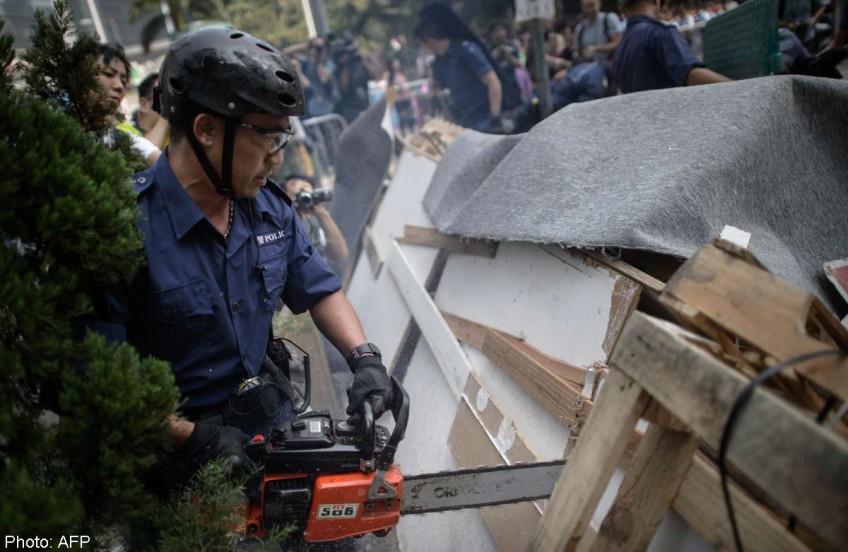Protesters vow to rebuild barricades

HONGKONG - Hundreds of Hong Kong police used sledgehammers and chainsaws to dismantle pro-democracy barricades near government offices and the city's financial centre on Tuesday, reopening a major road for the first time since protests began two weeks ago.
In a setback to protesters, traffic flowed freely along Queensway Road after their sit-in and barricades were cleared from the road. But other major protest sites remained in tact in the Admiralty and Mong Kok districts and pro-democracy demonstrators were defiant. "We will rebuild them after the police remove them," said protester Bruce Sze. "We won't confront the police physically." Unlike Monday, which saw clashes between anti-protest groups and pro-democracy activists after police removed barricades, Tuesday's operation resulted in no such confrontations.
However, tensions are expected to escalate on Wednesday when taxi drivers, who say business has dropped by around 50 per cent, have threatened to remove barricades if protesters have not cleared them by then. Truck drivers have made similar threats.
Taxi and truck drivers were among those who tried to dismantle barricades on Monday when hundreds of people, some wearing surgical masks and carrying crowbars and cutting tools, tore down barricades and clashed with protesters. "Reopening of (Queensway) is better than nothing at all as it allows more options to the drivers. But still it is not good enough and traffic will still be very heavy," said 53-year-old taxi driver Li Hung-on. "My income was down by half in the past two weeks and drivers like us are still the victims. It would be good if all the roads resume normal." The protesters, mostly students, are demanding full democracy for the former British colony, but their two-week standoff has caused traffic chaos and fuelled frustrations in the Asian financial hub, draining some public support.
Some of the city's most powerful tycoons had warned prior to the protests that any moves to occupy the heart of the city could undermine Hong Kong's stability. They have remained largely silent since the protests kicked off.
Police, criticised for using tear gas and batons in the first 24 hours of the protests, have adopted a more patient approach, counting on protesters to come under public pressure to clear some of the city's major arteries.
The removal of barricades but not protesters by Hong Kong police suggests a strategy of slow attrition, similar to that used against Occupy Wall St protests.
Protester numbers have dwindled significantly from their peak of around 100,000 at three sites, but observers believe they will sit it out. "I don't think the protesters, having suffered tear gas, endured the attacks by the anti occupy people, I don't think they will just surrender unconditionally and leave," said Joseph Wong, political analyst at the University of Hong Kong.
TRAFFIC FLOWS AGAIN By noon on Tuesday, the main thoroughfare of Queensway Road was reopened allowing traffic, including school and tour buses, to flow to the Central business district that is home to global companies such as HSBC Holdings and Standard Chartered.
Engineers were checking tram lines in Admiralty district, where "Not in Service' trams rolled through, apparently preparing to restart operations.
Around 100 protesters staged a sit-in outside the Admiralty Centre shopping complex surrounded by scores of police.
Police say the removal of barricades is aimed at easing congestion and that protesters can stay, but many students believe Monday's clashes were co-ordinated and involved triad criminal groups and people paid to cause trouble. They said some police stood by or did not act quickly enough.
Student protesters reinforced barricades late on Monday, erecting bamboo scaffolding four metres high along one major thoroughfare, while others mixed concrete to pour over the foundations of their road blocks. Makeshift spears made of bamboo protruded from some of the barricades.
On Tuesday, police with chainsaws cut down the towering bamboo structures and used sledgehammers to smash cemented barricades outside the Bank of China's Hong Kong headquarters and next to the office of Asia's richest man, Li Ka-shing.
Scores of office workers streamed out onto the streets to watch as police tore down the barricades.
China rules Hong Kong under a "one country, two systems"formula that accords the former British colony a degree of autonomy and freedoms not enjoyed in mainland China, with universal suffrage set as an eventual goal.
The protesters have called on the city's embattled leader, Leung Chun-ying, to step down after Beijing in August ruled out free elections for Hong Kong's next leader in 2017.
Leung has vowed to remain in office and warned that there was "zero chance" that China's leaders in Beijing would change an August decision limiting democracy in Hong Kong.